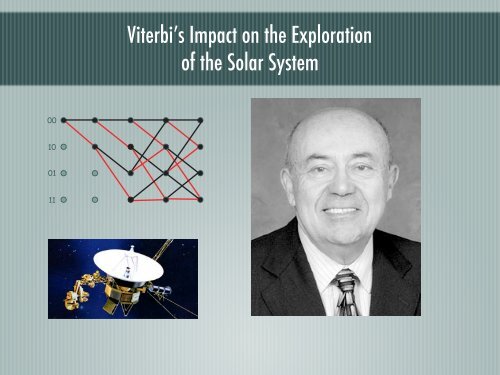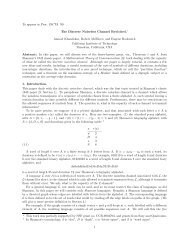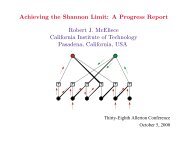Viterbi's Impact on the Exploration of the Solar System
Viterbi's Impact on the Exploration of the Solar System
Viterbi's Impact on the Exploration of the Solar System
Create successful ePaper yourself
Turn your PDF publications into a flip-book with our unique Google optimized e-Paper software.
Viterbi’s <str<strong>on</strong>g>Impact</str<strong>on</strong>g> <strong>on</strong> <strong>the</strong> Explorati<strong>on</strong><br />
<strong>of</strong> <strong>the</strong> <strong>Solar</strong> <strong>System</strong>
Pro<strong>of</strong> <strong>of</strong> Optimality <strong>of</strong><br />
Orthog<strong>on</strong>al Codes<br />
First Appearance <strong>of</strong><br />
Eb<br />
N0<br />
> ln 2
have made use <strong>of</strong> <strong>the</strong> fact that go(p) is c<strong>on</strong>cave.<br />
property b) we have lim,,,, &(p)/p =<br />
. Thus we obtain<br />
1<br />
<strong>on</strong>ent E,(R) in <strong>the</strong> lower bound is a positive<br />
decreasing c<strong>on</strong>tinuous functi<strong>on</strong> <strong>of</strong> R for all<br />
ical c<strong>on</strong>structi<strong>on</strong> <strong>of</strong> <strong>the</strong> exp<strong>on</strong>ent-rate curve<br />
t <strong>of</strong> <strong>the</strong> functi<strong>on</strong> E,,(p) is shown in Fig. 4. We<br />
er c<strong>on</strong>siderati<strong>on</strong> <strong>of</strong> <strong>the</strong> properties <strong>of</strong> (16)<br />
an upper bound is obtained.<br />
r lower bound <strong>on</strong> error probability for low<br />
tained by replacing <strong>the</strong> sphere packing bound<br />
<strong>the</strong> tighter lower bound for low rates recently<br />
by Shann<strong>on</strong>, Gallager, and Berlekamp.17’ For<br />
(6) is replaced by<br />
AFOSR-700-65.<br />
I -lim [P 111 F T p(4pb’)<br />
m<br />
&P(Y I 4P(Y I ~‘>Yl~ = &(i3. (17b)<br />
Y<br />
ht line <strong>of</strong> (17a) is tangent to <strong>the</strong> curve <strong>of</strong> (6)<br />
+ 1)/p@;(p). Repeating <strong>the</strong> minimizati<strong>on</strong> with<br />
CL we find<br />
E&l = min [(P + l)Ez - &RI<br />
*<br />
have<br />
2<br />
0 < R < Elbl<br />
=E,, -MC.<br />
rates a tighter lower bound than that <strong>of</strong><br />
1 is:<br />
PX > & i -NE&) + o(N)lJ<br />
where<br />
(b) p’l<br />
Fig. 4. Graphical c<strong>on</strong>structi<strong>on</strong> <strong>of</strong> EL(R) from I%(P).<br />
Error Bounds for C<strong>on</strong>voluti<strong>on</strong>al Codes<br />
and an Asymptotically Optimum<br />
Decoding Algorithm<br />
p’ is <strong>the</strong> soluti<strong>on</strong> ANDREW to J. <strong>the</strong> VITERBI, equati<strong>on</strong> SENIOR E,,(c) MEMBER, = E,, IEEE and E, is<br />
given by (17b).<br />
Ahstraci-The probability <strong>of</strong> error in decoding an optimal c<strong>on</strong>voluti<strong>on</strong>al<br />
code transmitted over a memoryless channel is bounded<br />
from above and below as a functi<strong>on</strong> <strong>of</strong> <strong>the</strong> c<strong>on</strong>straint length <strong>of</strong> <strong>the</strong><br />
code. For all but pathological channels <strong>the</strong> bounds are asymptotically<br />
(exp<strong>on</strong>entially) tight for rates above &, <strong>the</strong> computati<strong>on</strong>al cut<strong>of</strong>f<br />
rate <strong>of</strong> sequential decoding. As a functi<strong>on</strong> <strong>of</strong> c<strong>on</strong>straint length <strong>the</strong><br />
performance <strong>of</strong> optimal c<strong>on</strong>voluti<strong>on</strong>al codes is shown to be superior<br />
to that <strong>of</strong> block codes <strong>of</strong> <strong>the</strong> same length, <strong>the</strong> relative improvement<br />
IV. A PROBABILISTIC NONSEQTJENTIAL DECODING<br />
ALGORITHM<br />
We now describe a new probabilistic n<strong>on</strong>sequential<br />
decoding algorithm which, as we shall show in <strong>the</strong><br />
next secti<strong>on</strong>, is asymptotically s optimum for rates R ><br />
R, = E,(l). The algorithm decodes an L-branch tree<br />
by performing L repetiti<strong>on</strong>s <strong>of</strong> <strong>on</strong>e basic step. We adopt<br />
<strong>the</strong> c<strong>on</strong>venti<strong>on</strong> <strong>of</strong> denoting each branch <strong>of</strong> a given path<br />
by its data symbol ai, an element <strong>of</strong> GE(q). Also, although<br />
GE(q) is isomorphic to <strong>the</strong> integers modulo (r <strong>on</strong>ly when<br />
Q is a prime, for <strong>the</strong> sake <strong>of</strong> compact notati<strong>on</strong>, we shall<br />
use <strong>the</strong> integer r to denote <strong>the</strong> rth element <strong>of</strong> <strong>the</strong> field.<br />
In Step 1 <strong>the</strong> decoder c<strong>on</strong>siders all qK paths for <strong>the</strong><br />
first K branches (where K is <strong>the</strong> branch c<strong>on</strong>straint length<br />
<strong>of</strong> <strong>the</strong> code) and computes all qK likelihood functi<strong>on</strong>s<br />
n;?I1 p(y, 1 ai). The decoder <strong>the</strong>n compares <strong>the</strong> likelihood<br />
functi<strong>on</strong> for <strong>the</strong> q paths:<br />
Manuscript received May 20, 1966; revised November 14, 1966.<br />
The research for this work was sp<strong>on</strong>sored by Applied Ma<strong>the</strong>matics<br />
Divisi<strong>on</strong>, Office <strong>of</strong> Aerospace Research, U. S. Air Force, Grant<br />
The author is with <strong>the</strong> Department <strong>of</strong> Engineering, University <strong>of</strong><br />
California, Los Angeles, Calif.<br />
(0, az, a, . . * 4,<br />
0, a2, a3, ... ad,<br />
. . . . . . . . . . . . . . . . . .<br />
(a - 1, az, a3, . . . ad<br />
Increasing with rate. The upper bound is obtained for a specific<br />
probabilistic n<strong>on</strong>sequential decoding algorithm which is shown to be<br />
asymptotically optimum for rates above Ra and whose performance<br />
bears certain similarities to that <strong>of</strong> sequential decoding algorithms.<br />
I. SUMMARY OF RESULTS<br />
INCE Elias”] first proposed <strong>the</strong> use <strong>of</strong> c<strong>on</strong>voluti<strong>on</strong>al<br />
(tree) codes for <strong>the</strong> discrete memoryless channel,<br />
it has been c<strong>on</strong>jectured that <strong>the</strong> performance <strong>of</strong><br />
this class <strong>of</strong> codes is potentially superior to that <strong>of</strong> block<br />
codes <strong>of</strong> <strong>the</strong> same length. The first quantitative verificati<strong>on</strong><br />
<strong>of</strong> this c<strong>on</strong>jecture was due to Yudkinr2’ who obtained<br />
for each <strong>of</strong> <strong>the</strong> qK-l possible vectors (az, a3 . . . ar;).<br />
It thus performs qIcel comparis<strong>on</strong>s each am<strong>on</strong>g q path<br />
likelihood functi<strong>on</strong>s. Let <strong>the</strong> path corresp<strong>on</strong>ding to <strong>the</strong><br />
greatest likelihood functi<strong>on</strong> in each comparis<strong>on</strong> be denoted<br />
<strong>the</strong> survivor. Only <strong>the</strong> q”-’ survivors <strong>of</strong> as many com-<br />
paris<strong>on</strong>s are preserved for fur<strong>the</strong>r c<strong>on</strong>siderati<strong>on</strong>; <strong>the</strong><br />
remaining paths are discarded. Am<strong>on</strong>g <strong>the</strong> qK-’ survivors
EE/Ma 127b, Class Project 2
No Coding (Pre 1969)<br />
(32,6) Biorthog<strong>on</strong>al Block Code (1969 - 1975)<br />
K =7, R = 1/2 C<strong>on</strong>v. Code + Viterbi Decoding (1977 -- 1986)<br />
Plus Reed-Solom<strong>on</strong> if Data Compressi<strong>on</strong> is Used<br />
K= 15, R = 1/6 CC/VD + RS (1986 -- 2004)<br />
Turbo Codes (2004 -- ?)<br />
LDPC Codes (2006 -- ?)<br />
Jet Propulsi<strong>on</strong> Laboratory<br />
Interplanetary Error-C<strong>on</strong>trol Codes
No Coding: The Early Mariners<br />
Mariner 2, 1962<br />
Venus Flyby<br />
Mariner 4, 1965<br />
Mars Flyby<br />
First close-up photographs <strong>of</strong> ano<strong>the</strong>r planet.<br />
Mariner 5, 1967<br />
Venus Flyby
Mariners 6, 7 (1969)<br />
Mars Flyby<br />
Mariner 9 (1971)<br />
Mars Orbit<br />
(32,6) Biorthog<strong>on</strong>al Code +<br />
“Green Machine” Decoding<br />
+ + + +<br />
+ − + −<br />
+ + − −<br />
+ − − +<br />
+ + + +<br />
+ − + −<br />
+ + − −<br />
+ − − +<br />
− − − −<br />
− + − +<br />
− − + +<br />
− + + −<br />
− − − −<br />
− + − +<br />
− − + +<br />
− + + −<br />
+ + + +<br />
+ − + −<br />
+ + − −<br />
+ − − +<br />
− − − −<br />
− + − +<br />
− − + +<br />
− + + −<br />
− − − −<br />
− + − +<br />
− − + +<br />
− + + −<br />
+ + + +<br />
+ − + −<br />
+ + − −<br />
+ − − +<br />
The (8,4) biorthog<strong>on</strong>al code
Mariner 10, 1973-1974<br />
Mercury and Venus<br />
Viking Mars Landers, 1976<br />
Mars’ Surface<br />
(32,6) Biorthog<strong>on</strong>al Code/<br />
“Green Machine” Decoding<br />
+ + + +<br />
+ − + −<br />
+ + − −<br />
+ − − +<br />
+ + + +<br />
+ − + −<br />
+ + − −<br />
+ − − +<br />
− − − −<br />
− + − +<br />
− − + +<br />
− + + −<br />
− − − −<br />
− + − +<br />
− − + +<br />
− + + −<br />
+ + + +<br />
+ − + −<br />
+ + − −<br />
+ − − +<br />
− − − −<br />
− + − +<br />
− − + +<br />
− + + −<br />
− − − −<br />
− + − +<br />
− − + +<br />
− + + −<br />
+ + + +<br />
+ − + −<br />
+ + − −<br />
+ − − +<br />
The (8,4) biorthog<strong>on</strong>al code
Voyagers 1&2 (1977-- )<br />
“Grand Tour”<br />
K= 7, R = 1/2 C<strong>on</strong>voluti<strong>on</strong>al Code<br />
with Viterbi Decoding<br />
Magellan Venus Radar Mapper (1989-1993)<br />
Mars Global Surveyor (1997- )
Galileo (1989 -- 2003)<br />
A Sea <strong>of</strong> Troubles<br />
Mars Pathfinder (1996- 1997)<br />
Sojourner<br />
K = 15 C<strong>on</strong>voluti<strong>on</strong>al Codes with<br />
Big Decoding
Cassini (1997 ---- )<br />
K = 15 C<strong>on</strong>voluti<strong>on</strong>al Codes with<br />
Big Decoding<br />
Huygens Titan Probe, 2005<br />
Mars Explorati<strong>on</strong> Rover (2003--2004)<br />
Spirit and Opportunity
A Brave New World :Turbo Codes<br />
Messenger to Mercury (APL Missi<strong>on</strong>: 2004--2011)<br />
Mars Rec<strong>on</strong>naissace Orbiter (Aug 2005 Launch)<br />
Both use (8920, 1/6) CCSDS turbo code
Back to <strong>the</strong> Future: LDPC Codes<br />
Mars Telecomm Orbiter 2010<br />
And Bey<strong>on</strong>d ?<br />
The Tanner Graph<br />
1 2 3 4 5 6<br />
⎛<br />
⎞<br />
A 1 1 0 1 0 1<br />
B ⎝ 1 0 1 1 1 0⎠.<br />
C 0 1 1 0 1 1<br />
1 2 3 4 5 6<br />
= = = = = =<br />
A B C<br />
22
log 10 Pb<br />
-1<br />
-2<br />
-3<br />
-4<br />
SHANNON<br />
LIMIT -5<br />
-1.59 dB<br />
-6<br />
Voyager<br />
SUMMARY<br />
Galileo<br />
Messenger Pathfinder<br />
Voyager<br />
MER MGS<br />
MRO Cassini<br />
Mariner 10<br />
Magellan<br />
Viking<br />
Mariner 4<br />
Uncoded<br />
(32,6) Biorthog<strong>on</strong>al<br />
(7, 1/2) C<strong>on</strong>v.Code<br />
(7, 1/2) + (255,223) RS<br />
(15,1/6) + (255,223) RS<br />
(8920, 1/6) Turbo<br />
-1.0 1.0 3.0 5.0 7.0 9.0 11.0<br />
Eb/N0, dB
Claude Shann<strong>on</strong>:<br />
“The fundamental problem <strong>of</strong> communicati<strong>on</strong> is that <strong>of</strong> reproducing<br />
at <strong>on</strong>e point ei<strong>the</strong>r exactly or approximately a message selected at<br />
ano<strong>the</strong>r point.”<br />
“Frequently <strong>the</strong> messages have meaning”
A Tour <strong>of</strong> <strong>the</strong> <strong>Solar</strong> <strong>System</strong><br />
On <strong>the</strong> Occasi<strong>on</strong> <strong>of</strong> Andrew Viterbi’s 70th Birthday.<br />
Ludwig van Beethoven, Mo<strong>on</strong>light S<strong>on</strong>ata<br />
Daniel Barenboim, pianist
Mercury<br />
Mariner 10<br />
1974
Venus<br />
Magellan<br />
1990
The Far Side <strong>of</strong> <strong>the</strong> Mo<strong>on</strong><br />
Apollo 16<br />
1972
Mars<br />
ars Global Surveyor<br />
1997
The Surface <strong>of</strong> Mars<br />
Mars Pathfinder<br />
1998
The Asteroid Gaspra<br />
Galileo<br />
1991
Jupiter<br />
Voyager 1<br />
1979
Jupiter’s mo<strong>on</strong> Io<br />
Galileo<br />
1996
Io above Jupiter<br />
Cassini<br />
2004
Jupiter’s mo<strong>on</strong> Europa<br />
Galileo<br />
2000
Jupiter’s mo<strong>on</strong> Callisto<br />
Galileo<br />
2001
Saturn<br />
Cassini<br />
2004
Saturn’s mo<strong>on</strong> Titan<br />
Cassini<br />
2004
Saturn’s mo<strong>on</strong> Phoebe<br />
Cassini<br />
2005
Uranus<br />
Voyager 2<br />
1986
Neptune<br />
Voyager 2<br />
1989
Pluto and its mo<strong>on</strong> Char<strong>on</strong><br />
Hubble Space Telescope<br />
1994<br />
??
EEarthrise<br />
Apollo 8<br />
1968<br />
We shall not cease from explorati<strong>on</strong><br />
And <strong>the</strong> end <strong>of</strong> all our exploring<br />
Will be to arrive where we started<br />
And know <strong>the</strong> place for <strong>the</strong> first time.<br />
-T. S. Eliot
Happy Birthday Andy!






